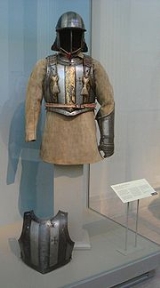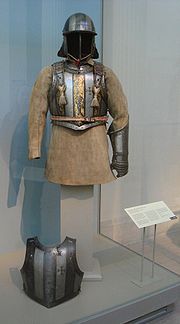
Capeline
Encyclopedia
Capeline is the name given to two distinct types of post-Renaissance helmet

 The first was a steel skullcap
The first was a steel skullcap
(known as a "secrete" when worn under a hat) usually worn by archers that continued to be worn into the 17th century by musketeers and horsemen who wished to wear fashionable broad-brimmed hats but also retain some level of protection for the head. It was also worn by civilians under their regular hats, including the judges at Charles I's trial. The prosecutor John Bradshaw
feared assassination so had a special metal hat made to protect him.
, commonly known as a lobster tail pot. This was worn along with the buff coat
, gauntlets and breastplate
by Oliver Cromwell
's Ironside cavalry. Another famous unit to use it was the London lobsters
; unusual for the time they had armor that covered most of the body.
The lobster-tailed pot had articulated cheek-pieces; a fixed forward projecting peak that included a sliding nasal bar, or, alternatively, a hinged peak with three attached bars to protect the trooper's face from sword cuts; and an articulated "tail" protecting the back of the head and neck that was said to resemble that of a lobster. Another common name for it was the "harquebusier's pot", the harquebusier
being the most common type of cavalry in Western Europe during the 17th century.
The helmet had an oriental origin, being derived from the Ottoman
Turkish 'chichak' (Turkish
- çiçak) helmet. It was adopted by the Christian states of Europe in the early 17th century. It saw widespread use during the Thirty Years War when it became known as the zischagge, a Germanisation of the original Turkish name. Many of these European-made capelines were later imported during the English Civil War. Sometimes older helmets like the burgeonet or sallet
were modified to resemble the lobster pot although these were less effective in the field.
Similar helmets were worn in the late 17th century by Polish winged hussars and Prussian cavalry, including Fredrick William
's forces at the Battle of Fehrbellin
(1672). The latter had a decorative fluted design and were painted black to prevent rust.


Skullcap
Skullcap or skull cap may refer to:* Calvaria , in anatomy, the top part of the skull* Headgear:** A Kippah or yarmulke, a small cloth skullcap worn by Orthodox Jewish men and some Jewish women...
(known as a "secrete" when worn under a hat) usually worn by archers that continued to be worn into the 17th century by musketeers and horsemen who wished to wear fashionable broad-brimmed hats but also retain some level of protection for the head. It was also worn by civilians under their regular hats, including the judges at Charles I's trial. The prosecutor John Bradshaw
John Bradshaw (judge)
John Bradshaw was an English judge. He is most notable for his role as President of the High Court of Justice for the trial of King Charles I and as the first Lord President of the Council of State of the English Commonwealth....
feared assassination so had a special metal hat made to protect him.
Cavalry helmet
The better-known Capeline is the cavalry helmet seen in the English Civil WarEnglish Civil War
The English Civil War was a series of armed conflicts and political machinations between Parliamentarians and Royalists...
, commonly known as a lobster tail pot. This was worn along with the buff coat
Buff coat
The European Buff coat was an item of leather clothing worn by both the infantry and cavalry during the 17th century, usually worn under armour...
, gauntlets and breastplate
Breastplate
A breastplate is a device worn over the torso to protect it from injury, as an item of religious significance, or as an item of status. A breastplate is sometimes worn by mythological beings as a distinctive item of clothing.- Armour :...
by Oliver Cromwell
Oliver Cromwell
Oliver Cromwell was an English military and political leader who overthrew the English monarchy and temporarily turned England into a republican Commonwealth, and served as Lord Protector of England, Scotland, and Ireland....
's Ironside cavalry. Another famous unit to use it was the London lobsters
London lobsters
The London lobsters, Haselrig's Lobsters or just "Lobsters" were the name given to the cavalry unit of Sir Arthur Haselrig, a Parliamentarian who fought in the English Civil War.-Background:...
; unusual for the time they had armor that covered most of the body.
The lobster-tailed pot had articulated cheek-pieces; a fixed forward projecting peak that included a sliding nasal bar, or, alternatively, a hinged peak with three attached bars to protect the trooper's face from sword cuts; and an articulated "tail" protecting the back of the head and neck that was said to resemble that of a lobster. Another common name for it was the "harquebusier's pot", the harquebusier
Harquebusier (cavalry)
The term Harquebusier was used to denote the most common form of cavalryman found in Western Europe during the early and mid 17th century.-Development:...
being the most common type of cavalry in Western Europe during the 17th century.
The helmet had an oriental origin, being derived from the Ottoman
Ottoman Empire
The Ottoman EmpireIt was usually referred to as the "Ottoman Empire", the "Turkish Empire", the "Ottoman Caliphate" or more commonly "Turkey" by its contemporaries...
Turkish 'chichak' (Turkish
Turkish language
Turkish is a language spoken as a native language by over 83 million people worldwide, making it the most commonly spoken of the Turkic languages. Its speakers are located predominantly in Turkey and Northern Cyprus with smaller groups in Iraq, Greece, Bulgaria, the Republic of Macedonia, Kosovo,...
- çiçak) helmet. It was adopted by the Christian states of Europe in the early 17th century. It saw widespread use during the Thirty Years War when it became known as the zischagge, a Germanisation of the original Turkish name. Many of these European-made capelines were later imported during the English Civil War. Sometimes older helmets like the burgeonet or sallet
Sallet
The sallet was a war helmet that replaced the bascinet in northern Europe and Hungary during the mid-15th century. Some sallets were close fitting except at the back of the head where they extended and formed a pointed tail. Some Italian ones followed the shape of the neck, and had an additional...
were modified to resemble the lobster pot although these were less effective in the field.
Similar helmets were worn in the late 17th century by Polish winged hussars and Prussian cavalry, including Fredrick William
Frederick William, Elector of Brandenburg
|align=right|Frederick William was Elector of Brandenburg and Duke of Prussia – and thus ruler of Brandenburg-Prussia – from 1640 until his death. A member of the House of Hohenzollern, he is popularly known as the "Great Elector" because of his military and political prowess...
's forces at the Battle of Fehrbellin
Battle of Fehrbellin
The Battle of Fehrbellin was fought on June 18, 1675 between Swedish and Brandenburg-Prussian troops. The Swedes, under Count Waldemar von Wrangel , had invaded and occupied parts of Brandenburg from their possessions in Pomerania, but were repelled by the forces of Frederick William, the Great...
(1672). The latter had a decorative fluted design and were painted black to prevent rust.

